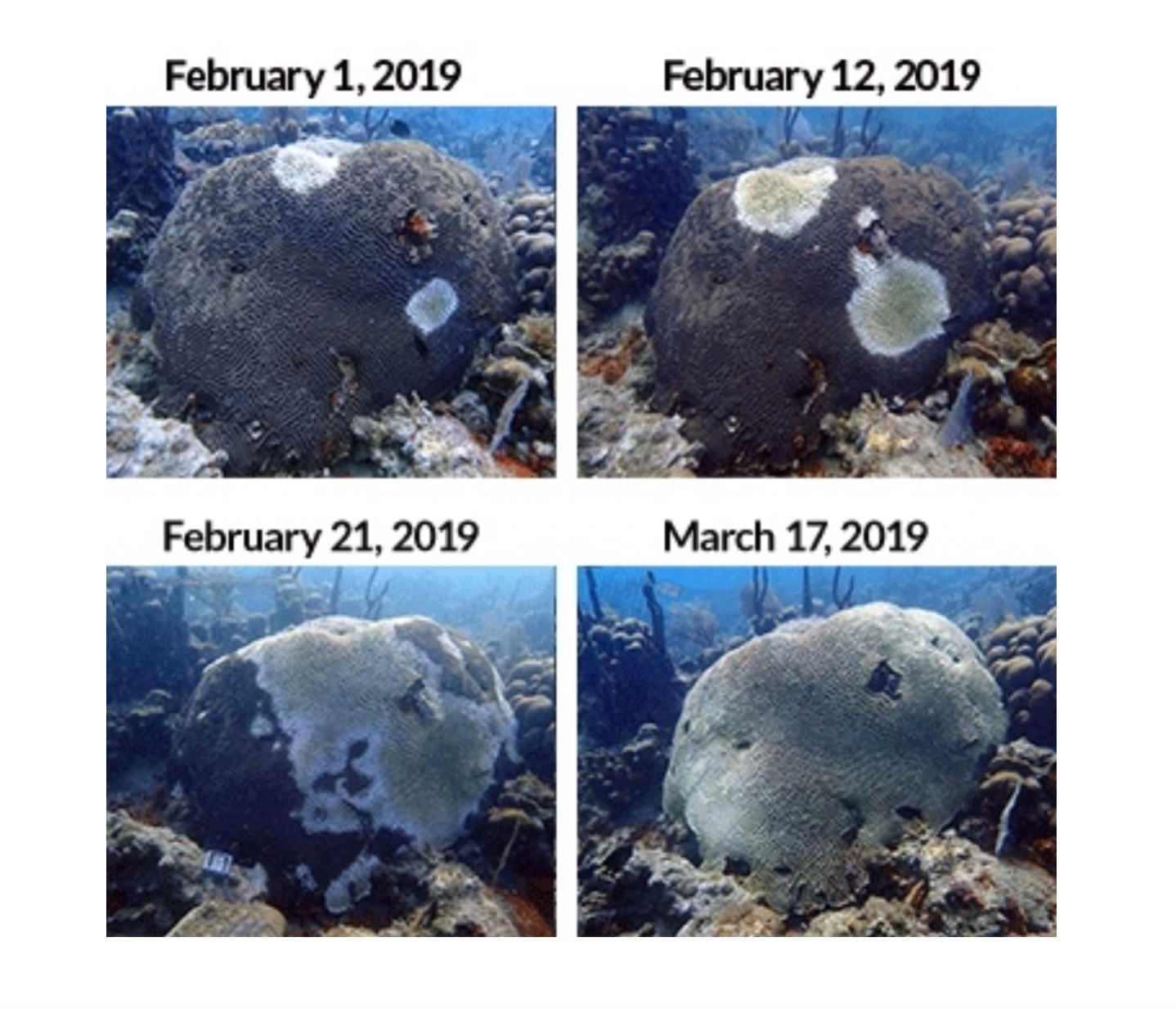Stony Coral Tissue Loss Disease (SCTLD) is ravaging coral communities throughout the Caribbean at rates reminiscent of the COVID-19 pandemic, posing a significant threat to marine ecosystems. This disease, often referred to as the “Covid” of corals, is rapidly spreading and causing widespread devastation, impacting the biodiversity and health of coral reefs.
As a scuba diver, the beauty of coral reefs has always been mesmerizing. However, witnessing the effects of SCTLD firsthand in Utila, Honduras, revealed the tragic reality of this disease. The vibrant ecosystems once teeming with life are now facing unprecedented challenges, necessitating urgent action to mitigate its impact.
This article explores the causes, impact, and potential solutions for SCTLD, drawing parallels to the COVID-19 pandemic to highlight the urgency and importance of addressing this marine crisis.
Understanding Stony Coral Tissue Loss Disease
Stony Coral Tissue Loss Disease (SCTLD) is a highly infectious and lethal disease affecting stony corals across the Caribbean. First reported in 2014 off the coast of Florida, it has since spread to reefs in Belize, Mexico, The Bay Islands, and the Dominican Republic, causing mass coral bleaching and mortality.
The disease is caused by a pathogen that attacks the coral’s tissue, leading to rapid tissue loss and eventual death. SCTLD affects various coral species, including brain corals (Pseudodiploria spp.), pillar corals (Dendrogyra Cylindrus), and star corals (Orbicella spp.), which are essential for reef building and habitat provision.
Symptoms of SCTLD include white patches on coral colonies, indicating tissue loss. These patches may have a fuzzy or slimy appearance, signifying the infection’s spread. The disease can cause entire coral colonies to die within weeks, leading to significant habitat loss and ecosystem collapse.
The Spread of SCTLD: A Complex Mystery
The exact mechanisms behind the spread of SCTLD are still under investigation. However, its highly infectious nature means that coral colonies in close proximity can quickly infect each other, leading to large-scale outbreaks. Theories suggest that water currents and direct contact between colonies may contribute to the disease’s transmission.
SCTLD leads to mass coral bleaching, where corals expel their symbiotic algae in response to stress. This loss of algae causes the coral to lose color and turn white. Unlike typical bleaching events, SCTLD causes coral tissue to die before it can bleach, leading to rapid and extensive mortality.
This disease has had a significant impact on Caribbean reef communities, with many native coral species being wiped out entirely. The loss of these corals greatly impacts the biodiversity of reef ecosystems, affecting marine life and coastal communities that depend on reefs for food, income, and tourism.
SCTLD’s Impact on Local Communities and Economies
The collapse of reef ecosystems due to SCTLD has significant social and economic consequences for coastal communities. Logan Pfeifle, a local scuba instructor in Utila, Honduras, notes, “In a place like Utila, which has a large part of its economy driven mostly by dive tourism, SCTLD affecting such a large part of the coral has a negative impact on the locals just trying to make a living.”
The decline in fisheries production and the loss of income from tourism have far-reaching effects. The tourism industry, heavily reliant on beautiful reefs, has been hit hard, leading to business closures and job losses.
The ecological impact is equally concerning, as the dying coral reefs disrupt the balance of the ocean ecosystem, affecting countless species of marine life and threatening the livelihoods of those who depend on it.
Community-Driven Conservation Efforts
Despite the challenges posed by SCTLD, local communities are actively working to raise awareness and find solutions. The diving industry has united to support conservation efforts, pooling resources to fund research and restoration projects.
Gaby Bertrand, program manager of the Whale Shark and Oceanic Research Center, emphasizes that “no project is too small to make a difference. Even just one person barefoot picking up trash on the beach is a step in the right direction.” These efforts highlight the importance of community involvement in addressing the crisis.
Ongoing efforts to control and contain the spread of SCTLD include promoting best practices, such as cleaning and disinfecting gear and limiting human contact with the reefs. Divers are encouraged to practice good buoyancy control to avoid contact with corals and report any signs of tissue loss to local authorities.
SCTLD and COVID-19: A Striking Comparison
Comparing the effects of Stony Coral Tissue Loss Disease to the COVID-19 pandemic reveals uncanny similarities in their spread, impact, and management. While affecting different organisms, both diseases share common traits.
Both diseases spread rapidly and widely, facilitated by human activity. Research Coordinator and Marine Biologist at the Whale Shark and Oceanic Research Center, Samantha Burgess, states, “This disease has swept across the island of Utila and decimated our hard coral populations at an astounding rate.” This mirrors the rapid spread of COVID-19 across the globe.
Prevention and control are key strategies for managing both diseases. For SCTLD, this involves preventing its introduction to new areas and monitoring infected sites. For COVID-19, measures include vaccination, social distancing, and mask-wearing. In both cases, a coordinated and collaborative approach is essential.
Protecting Our Coral Reefs: A Call to Action
Stony Coral Tissue Loss Disease poses a significant threat to coral reefs and the marine ecosystems they support. Addressing this crisis requires a comprehensive and collaborative approach, involving scientists, communities, and governments.
The parallels between SCTLD and the COVID-19 pandemic highlight the importance of understanding and protecting the health of the natural world. By taking action to prevent the spread of SCTLD and supporting conservation efforts, we can help ensure the survival of coral reefs for future generations.
Protecting coral reefs is not only an ecological imperative but also a social and economic one. By safeguarding these vital ecosystems, we can support the livelihoods of coastal communities and preserve the beauty and biodiversity of our oceans.
